|
Retire Early
Lifestyle
Retirement; like your parents, but way cooler

|
In 1991 Billy and Akaisha Kaderli retired at the age
of 38. Now, into their 4th decade of this
financially independent lifestyle, they invite you
to take advantage of their wisdom and experience. |
|
The
Alexander Hamilton Museum
Nevis, West Indies
Billy and Akaisha Kaderli
Currency Converter
You might know that
Alexander Hamilton was the first US Secretary of Treasury, and that he was one
of the Founding Fathers of the new nation called The United States.
If you are anything like
us... we realized how little we knew of this brilliant man who was born
illegitimately on the island of Nevis, a British colony at the time.
He showed his mental acuity
at an early age and his passage to New York was crowd-funded to give him the
best chance to become educated and therefore be able to display his talents.
Admission to this local
Museum is around $10USD which also gives you access to other museums and island
exhibits on the same property.
Let's take a look.

Bronze statue of Alexander Hamilton
Alexander Hamilton was born around January
11, 1755 (or 1757, as records are unclear) in
Charlestown, Nevis.
At this time, the island was a British colony in the West Indies.
His childhood here, which lasted until his
mid-teens, was marked by hardship. His father, James Hamilton, left the family
when Alexander was 11 and his mother, Rachel Fawcett Lavien died of a
fever, leaving him an orphan at age 13. While he did stay with a relative for a
short while, that relative committed suicide, leaving Alexander to fend for
himself at a very young age.
Because he was an illegitimate child, he
faced heavy social stigma and was not allowed to attend any formal school on the
island. But his mother ensured that Alexander received some education through
private tutors and a Jewish school in Charlestown.
By age 11, he was working as a clerk for
Beekman and Cruger, a trading firm, where his knack for numbers and writing
shone. He managed accounts, corresponded with merchants, and - when he was a
teenager - briefly ran the firm when the owner was away.
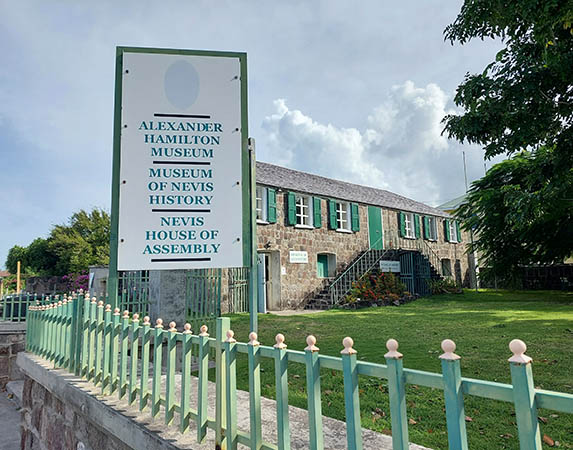
The Museum is in Trott House
Trott House was originally constructed
around1680 and marks the approximate site of Alexander's birthplace. This
Georgian-style building was destroyed by an earthquake in 1840 and rebuilt in
1983.
Charlestown was a bustling port town at the
time of Alexander's childhood. His father, James Hamilton, worked as a merchant
but struggled financially. When James abandoned his family, Rachel supported
them by running a small store, where young Alexander likely gained early
exposure to trade, bookkeeping, and the multicultural world of Caribbean
commerce.
Rachel was descended from French Huguenots
who were known for their work ethic, literacy, and commercial acumen, which
Hamilton inherited.
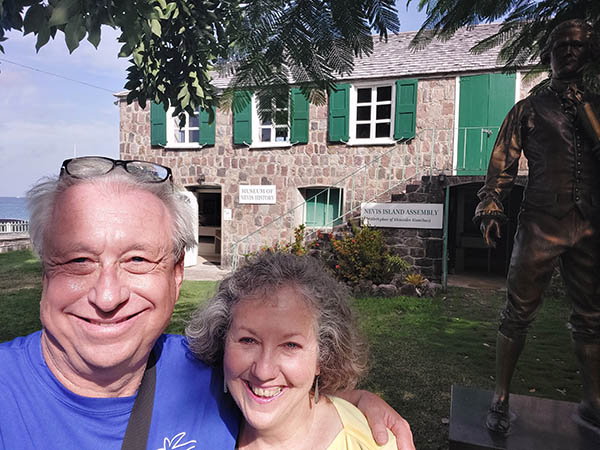
Billy and Akaisha in front of the museum
and House of Assembly
Nevis was a sugar colony heavily reliant on
enslaved
African labor. The Hamilton household likely included enslaved people, and
Alexander witnessed the brutal realities of plantation life. This environment
probably fostered his later abolitionist leanings.
Since Alexander was orphaned as a young
teenager, he found himself needing to navigate life with support from local
merchants like Thomas Stevens. His intellect caught the attention of Nevis
elites, including Rev. Hugh Knox, who mentored him and helped fund his education
in America.
His early clerkship
gave him economic insights, his outsider status fueled ambition, and his
Huguenot heritage instilled a drive for liberty. These traits carried into his
American education, his later bond with George Washington, and his relentless
work to build a nation resilient to the instability he witnessed in the
Caribbean.
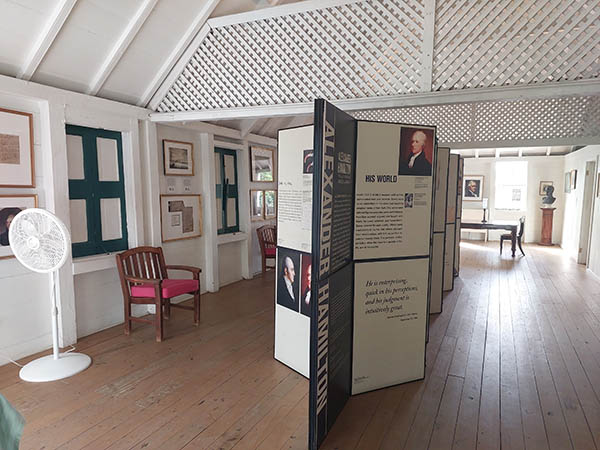
Displayed works of Alexander Hamilton
Alexander left Nevis around the age of 17 in
1772, funded by local merchants. He never returned.
Hamilton arrived in New York and his mentors,
including Rev. Hugh Knox, arranged for his education to prepare him for a
professional career.
He first attended a preparatory school,
Elizabethtown Academy in New Jersey, to bolster his self-taught education from
Nevis. There, he studied Latin, Greek, mathematics, and writing, showing
remarkable aptitude despite his late start compared to peers. Hamilton enrolled
at King’s College (now Columbia University) in New York City in 1773. He studied
law, history, and political philosophy, immersing himself in Enlightenment
thinkers like John Locke, whose ideas on governance later shaped his political
writings.
His formal education was interrupted by the
escalating Revolutionary War. By 1775, he joined a militia, prioritizing
revolutionary activities over completing his degree.
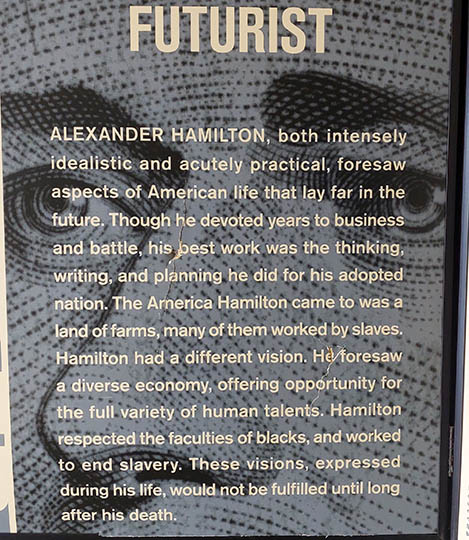
One of the posters in Hamilton's Museum
Hamilton’s education shifted to the
battlefield as he joined the New York Provincial Artillery Company in 1775.
His leadership and intellect, honed in
Nevis’s mercantile world and refined at King’s College, caught the attention of
higher-ups. In 1776, as a captain of artillery, he distinguished himself in
battles around New York, demonstrating strategic acumen and bravery.
George Washington was the commander of the
Continental Army and he recognized Hamilton’s talents through his writings and
military performance.
In March 1777, Washington invited the
22-year-old Hamilton to join his staff as an aide-de-camp with the rank of
lieutenant colonel. Alexander's multilingual skills from Nevis’s diverse port
and through his schooling, plus his writing prowess made him invaluable.
He drafted letters, negotiated with allies,
and handled intelligence, becoming one of Washington’s most trusted aides. Their
relationship, forged in the crucible of war, was professional but sometimes
strained due to Hamilton’s ambition and temper.
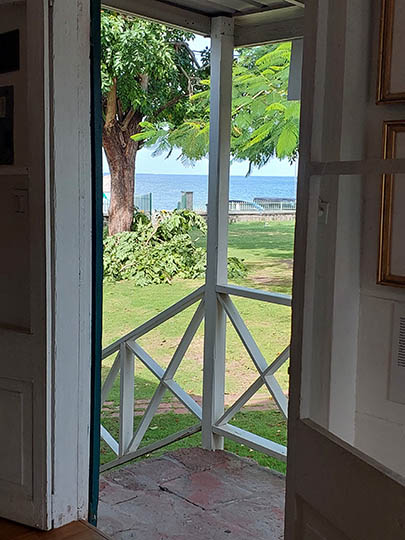
The view of the Caribbean Sea from the
House Assembly
As Washington’s aide, Hamilton shaped
military strategy and diplomacy, including correspondence with French allies
after 1778. Frustrated by desk work, he sought field command and, in 1781, led a
daring assault at the Battle of Yorktown, a decisive victory that showcased his
courage and tactical skill.
After Yorktown, Hamilton resigned from
Washington’s staff and studied law independently, passing the bar in 1782. Due
to his experience and war background, he held a belief in a strong central
government. He wrote essays like The Continentalist, advocating for a unified
nation with robust federal powers.
He was appointed by Washington as the first
U.S. Secretary of the Treasury, and in this capacity, he shaped the nation’s
economic foundation. His Reports on Manufactures in 1791 and plans for a
national bank, federal assumption of state debts, and tariffs established a
modern financial system. These policies stabilized the economy but sparked
debates with Jefferson and Madison over federal power, laying the groundwork for
the Federalist Party.
His role in the 1784 founding of the Bank of
New York showcased his economic vision, and he was elected to the New York
legislature in 1787.
Hamilton was fiercely ambitious but due to an
extramarital affair which became a huge scandal, and his abrasive style, his
electoral prospects were limited.
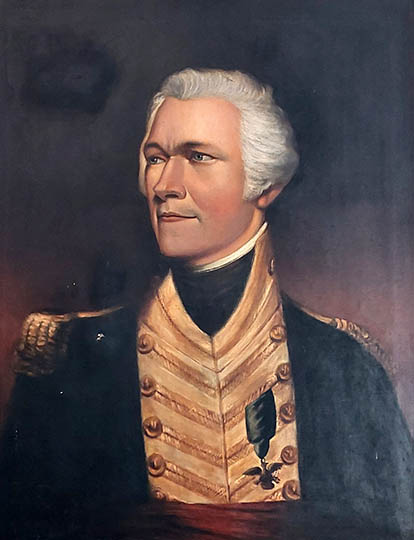
Portrait of Alexander Hamilton
You've probably heard about the duel between
Aaron Burr and Alexander Hamilton in 1804.
This is one of the most infamous events in
American history.
Burr and Hamilton were political adversaries
in the early United States.
Their rivalry intensified during the 1800
presidential election, when Hamilton’s influence helped Thomas Jefferson defeat
Burr for the presidency. Hamilton never trusted Burr whom he viewed as
opportunistic.
Hamilton, known for his sharp tongue, had
criticized Burr publicly for years, accusing him of lacking character. But their
social circles overlapped, and Burr was very sensitive to slights.
It got to a point where Burr felt his honor
was repeatedly attacked. And when Hamilton published a letter calling Burr “a
dangerous man” unfit for office, Burr had had enough, and challenged Hamilton to
a duel.
It was on the morning of July 11, 1804, when
Hamilton and Burr met at a dueling ground in New Jersey, across the Hudson River
from Manhattan.
The duel followed formal rules, with each man
armed with a .54-caliber pistol.
It is said that Hamilton intended to “throw
away his shot” by firing into the air to avoid bloodshed. Burr, however, fired
directly, hitting Hamilton in the abdomen. Hamilton’s shot went high, striking a
tree, suggesting he may have deliberately missed, and Burr was unharmed.
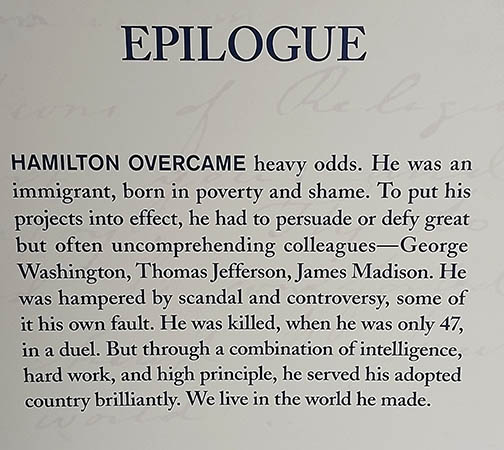
A poster from inside the museum
Hamilton, mortally wounded, was rowed back to
New York City, where he died the next day, July 12, 1804, at age 47 (or 49,
given his uncertain birth year). He was surrounded by family, including his
wife, Eliza, and expressed regret for the duel’s impact.
Burr fled to avoid prosecution, as dueling
was illegal both in New Jersey and in New York.
The duel destroyed Burr’s political career,
and he was branded a villain. Later, he drifted into obscurity, attempting
various ventures like a failed Western expedition. His reputation never
recovered, contrasting with Hamilton’s martyred legacy.
Hamilton’s death elevated his status as a
Founding Father. He made notable contributions to the Constitution, co-authored
the Federalist Papers, and influenced the U.S. financial system.
The duel underscored his fiery personality, a
trait traceable to his scrappy Nevis childhood, where he overcame illegitimacy
and orphanhood.
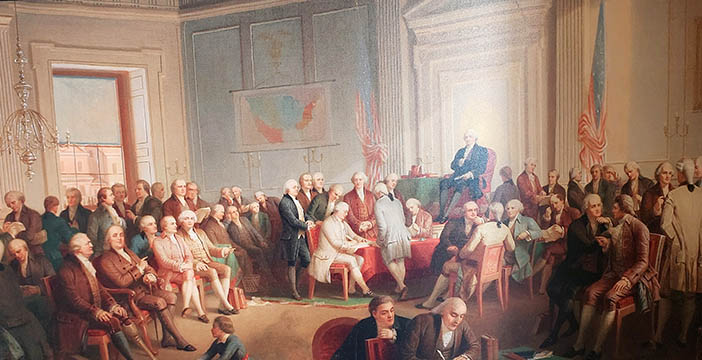
Famous painting depicting the signing of
the United States Constitution
This painting was created by Howard Chandler Christy in 1940.
It portrays the
Constitutional Convention of 1787 in Philadelphia, where delegates gathered to
draft the U.S. Constitution. On the left, in the first row you will find
Governor Morris, Benjamin Franklin, the man in blue might be Rufus King who is
touching Alexander Hamilton's shoulder. James Madison is next to Hamilton.
As a New York delegate to the Constitutional
Convention, Hamilton played a key role in crafting the U.S. Constitution.
He was a businessman, rose
to a statesman, military commander, and spoke several languages.
Though Alexander showed his
vulnerability in his personal relationships, his professional life was stellar.
These men who put this New
Nation together -The United States of America - were brilliant, dedicated, and
many of them were young and unafraid. They had a vision of a country where each
person could live in freedom and bring about the best life he was able to live
while being protected by the rule of law equally applied to all.
If you are in Nevis, be
sure to make a visit to the Alexander Hamilton Museum.



Retire
Early Lifestyle appeals to a different
kind of person – the person who prizes their
independence, values their time, and who doesn’t
want to mindlessly follow the crowd.
HOME
Book Store
Retire Early Lifestyle Blog
About Billy & Akaisha
Kaderli
Press
Contact
20 Questions
Preferred
Links
Retirement
Country Info
Retiree
Interviews
Commentary
REL
Videos
|